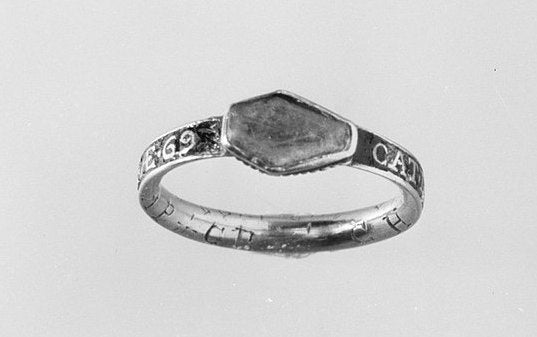It’s likely that the last time you attended a funeral, you came away with a wet hanky and maybe a program. But if you lived in eighteenth-century New England, you may have come home with a pair of gloves or a ring that declared your sorrow. Historians Steven C. Bullock and Sheila McIntyre explore the world of funeral tokens—swag given to attendees of a funeral and paid for by the deceased themselves.
“Only in eighteenth-century New England were elites expected, virtually required, to give freely to everyone at the funeral,” they write. Funeral attendees and mourners would receive everything from rings bearing the deceased person’s name to gloves to scarves.
Accounts of the gift giving don’t just let historians know more about funeral rituals and customs, they indicate who was important to the deceased. Though gifts were often offered to everyone invited to a funeral, they were always doled out to the most important attendees first. Usually, that started with the pallbearers and close family members and friends. Other attendees were gifted next (or not at all).

As the New England Historical Society notes, funerals represented a collecting opportunity for attendees, who cherished the items and often passed them on to their own loved ones when they died.
For Bullock and McIntyre, the custom of giving mourning gloves is especially significant. Giving gloves connected families and friends and reflected an increasingly industrial society. The practice even brought a kind of democracy to the funeral when the decedent refused to give more expensive gloves to members of their inner circle.
It makes sense that funerals played an important role in Colonial society—there were a lot of them. During the eighteenth century, a long string of epidemics swept through the colonies. Death rates were already high: Between 1760 and 1799, life expectancies were only in the 40s, and children died at a much higher rate than adults. Funerals were places to see and be seen, and people felt social pressure to give gifts at funerals (not to mention supplying every attendee with rum). Funeral gifts were even sent to those who could not attend.
To Bullock and McIntyre, New England funeral customs “represented an investment in relationships, an attempt to move beyond cold calculations of interest to create what social scientists call social capital.” They connect political and social movements—even the birth of the American Revolution—to the funerals that bound participants together in mourning and social interaction.
Finally, in 1742, Massachusetts banned giving rings, scarves, and large numbers of gloves at funerals in an attempt to curb spending. The justification was that huge funerals represented an unnecessary extravagance, supposedly bankrupting some families. Certainly, the massive funerals of eighteenth-century New England were expensive, but they soon became unnecessary social rituals to a society swept up in rebellion and then full-blown revolution. Funerals became more subtle, mourning less extravagant, and commemorating the dead slightly less fabulous.







